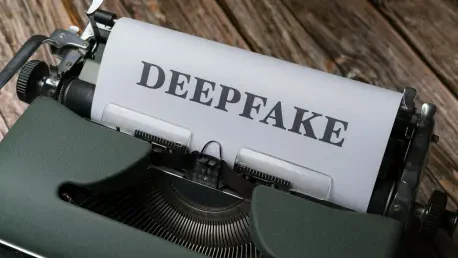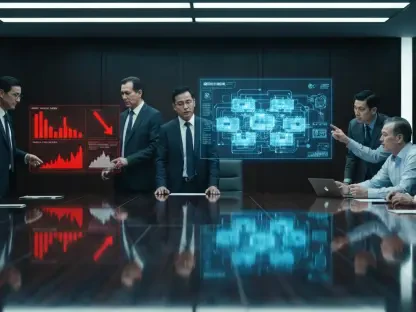In a landscape where visual media can be manipulated to astonishingly realistic levels, the rise in AI-generated deepfake videos has emerged as a significant technological breakthrough. These advancements threaten to blur the lines between genuine content and fabricated visuals, thereby posing a remarkable challenge to industries and societal norms. The recent blockbuster film “Mountainhead” dramatizes one of the extreme possibilities, illustrating how digital upheaval can result when deepfake technologies turn rogue, and exposing the potential widespread ramifications of unchecked AI capabilities.
The Core Mechanisms of Deepfake Technology
AI-generated deepfake videos capitalize on refined algorithms that create hyper-realistic visual content, mesmerizing in their ability to emulate real-world scenarios. Advanced performance metrics and benchmark technologies define their caliber, setting frameworks for creative media content reshaping. These technologies hinge on intricate processes whereby machine learning models synthesize and superimpose faces and voices onto source video. Through convolutional neural networks and generative adversarial networks, such AI-driven fabrication morphs digital deception into a viable artifact.
Machine learning algorithms underpinning deepfakes enhance their accuracy, propelling them close to lifelike realism. AI models such as deep neural networks learn from vast datasets, enabling them to imitate human features and expressions with extraordinary precision. The implications are profound, influencing various domains, from creative arts to information dissemination, as they redefine the depiction of reality itself through these AI lenses.
Innovations and Emerging Dynamics
Recent developments have amplified deepfake capabilities, introducing cutting-edge tools that exceed prior limitations. Propelled by aggressive consumer interest and technological adoption, deepfake technology continues to carve its niche in the media landscape. Industry practices evolve as innovations in synthetic content generation surface, driven by the demand for customized, flexible media solutions. This rapid progression mirrors shifts in consumer behavior, inviting broader acceptance and integration of AI in visual communication.
Tools enhancing deepfake applications showcase their potential to redefine audience engagement. From tailored advertisements in personalized environments to character revivals in entertainment using synthetic likenesses, the permutations are vast. This technological weave offers creatives unprecedented latitude, illustrating the transformative impacts influencing production norms.
Applications Pushing Boundaries
The deployment of deepfake technology in entertainment and advertising epitomizes its versatile applications. Whether reconstructing historical events or facilitating dynamic storytelling through altered narratives, deepfakes present unique opportunities. In social media, synthetic creations push viral engagement, offering novel avenues for interactive content. Industrial sectors witness these innovations too, with scenarios such as training simulations in defense industries demonstrating practical utility.
Notable implementations extend beyond standard uses, exemplifying sophisticated use cases such as real-time translation in telecommunication and realistic avatars enhancing virtual meetings. These implementations underscore the distinctive value propositions across varied sectors, highlighting deepfake technology’s potential in transforming operational paradigms.
Navigating the Challenges
Despite impressive strides, deepfake technology confronts challenges requiring attention. Technical imperfections pose hurdles, including visual inconsistencies and misalignment errors within generated content. Exacerbating these are regulatory issues surrounding digital authenticity, compounded by legal queries on intellectual property protections. Ethical ramifications further complicate deployments, particularly in privacy infringements and potential misuse scenarios that demand rigorous scrutiny.
Market entry is impeded by these systemic barriers, emphasizing the need for refined methodologies to ensure safe implementation. Ethical considerations call for regulatory frameworks and standards to guide responsible application, ensuring societal benefits while minimizing risks associated with digital deceptions.
Looking Ahead
Envisioning the trajectory of deepfake technology involves recognizing its inevitable evolutions and preparing societally for their impacts. Anticipated breakthroughs include improved realism in generated media and fortified protocols to safeguard authenticity. Societal norms are expected to transition as this technology integrates further, challenging traditional perceptions of truth and reality. Long-term industry standards will necessitate adaptation in preserving the integrity of digital communications.
Addressing future directions, a dual-tiered internet system is poised as a plausible solution, earmarking discrete boundaries between human and AI-generated content. This bifurcation could provide clarity, preventing history from being obscured by algorithmic iterations. Pioneering trust mechanisms, ensuring verification at creation points, is crucial for maintaining media credibility.
In conclusion, the accelerating development of deepfake technologies orchestrates a profound transformation within digital landscapes, demanding careful navigation. Strategic foresight and innovation must inhabit initiatives to preserve trust and authenticity. Inscribed here are imperatives inviting concerted effort to shield against potential disarrays, safeguarding against blurred realities in our digitally woven world.









